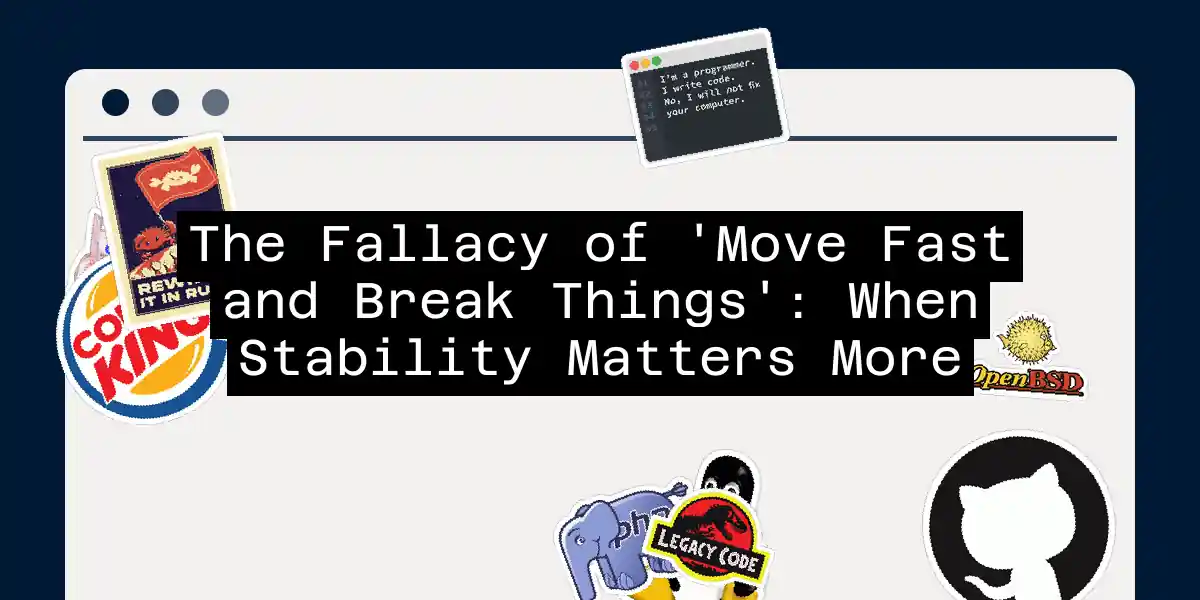The Allure and the Pitfall of “Move Fast and Break Things”
In the fast-paced world of software development, the mantra “move fast and break things” has become a rallying cry for many. Popularized by Mark Zuckerberg, this approach promises rapid innovation and progress, but it often overlooks the critical importance of stability and reliability. As someone who has navigated the trenches of software development, I’m here to argue that this mantra, while appealing, can be a recipe for disaster if not balanced with careful planning and robust processes.
The Origins and Misinterpretations
“Move fast and break things” was never meant to be a carte blanche for reckless development. It was intended to encourage experimentation and learning through failure, but with the understanding that these failures should be managed and mitigated.
However, the phrase has been misinterpreted to mean that speed is paramount, regardless of the consequences. This misinterpretation can lead to a culture where breaking things is seen as a necessary evil, rather than a controlled and manageable part of the development process.
The Consequences of Moving Too Fast
When you prioritize speed over stability, several issues arise:
Customer Confidence and Sales: Breaking things can lead to downtime, data loss, and a poor user experience. This erodes customer trust and can result in lost sales and revenue.
Employee Burnout: Constantly dealing with the fallout of broken systems can lead to burnout among developers and operations teams. This not only affects morale but also increases turnover rates.
Incident Resolution Time: Without proper processes in place, resolving incidents can take significantly longer. This prolongs the period of customer dissatisfaction and operational inefficiency.
The Importance of Processes
To truly move fast without breaking things, you need robust processes and tools. Here are some key elements to consider:
Release Engineering: Having a dedicated release engineering team can protect the production site from poorly tested code. This team ensures that changes are thoroughly vetted before they reach users.
Monitoring and Alerting: Implementing strong monitoring and alerting mechanisms helps identify issues quickly. This includes setting up on-call rotations and escalation procedures to ensure that problems are addressed promptly.
Feature Management: Tools like feature flags allow you to roll out changes gradually and safely. This enables you to test new features in production without exposing all users to potential issues.
Chaos Engineering: Scheduling chaos days or game days helps teams practice responding to failures. This builds resilience and ensures that when things do break, the team is well-prepared to fix them quickly.
A Practical Example: Feature Rollouts
Let’s consider a practical example of how to roll out a new feature safely:
In this sequence diagram, the feature is first deployed to a staging environment where it is thoroughly tested by the QA team. Once approved, it is rolled out to a small subset of users (canary release) to gather feedback and identify any issues before a full rollout.
Balancing Speed and Stability
The key to successful software development is finding a balance between speed and stability. Here are some steps to achieve this balance:
Psychological Safety: Foster a culture where employees feel safe to speak up about concerns and suggest improvements. This encourages open communication and teamwork.
Smart Tooling: Invest in tools that make development, testing, and deployment easier and more reliable. These tools should help in identifying and resolving issues quickly.
Gradual Rollouts: Use techniques like canary releases, beta testing, and feature flags to introduce changes gradually. This minimizes the impact of any potential issues.
Continuous Learning: Encourage a culture of continuous learning from failures. Use these failures as opportunities to improve processes and tools.
Conclusion
“Move fast and break things” is not a one-size-fits-all solution. It requires careful planning, robust processes, and the right tools to ensure that speed does not come at the cost of stability. By understanding the importance of balance and implementing the right strategies, you can innovate rapidly without sacrificing the reliability and trust that your customers and team members depend on.
So, the next time someone tells you to “move fast and break things,” remember that it’s not about being reckless; it’s about being smart, prepared, and customer-centric. After all, as the saying goes, “a ship in harbor is safe, but that’s not what ships are made for.” But let’s make sure our ships are seaworthy before we set sail.
